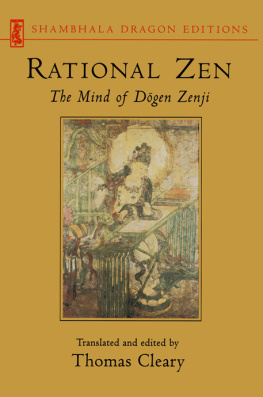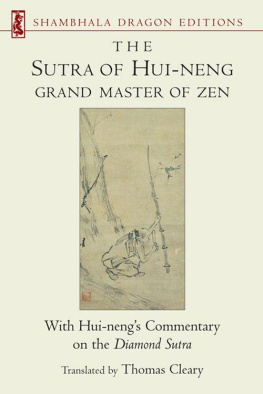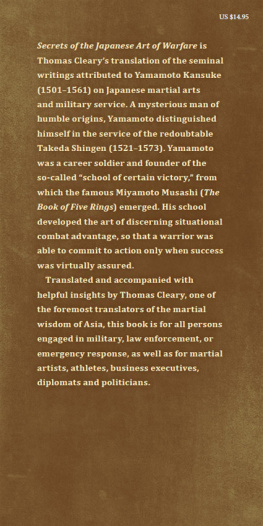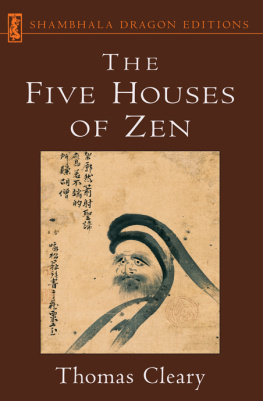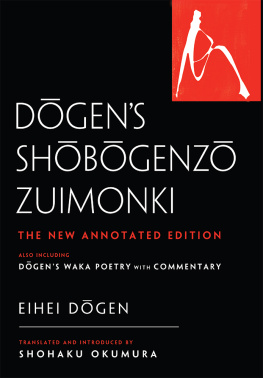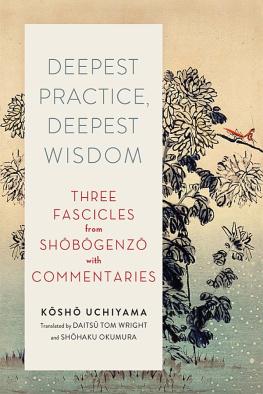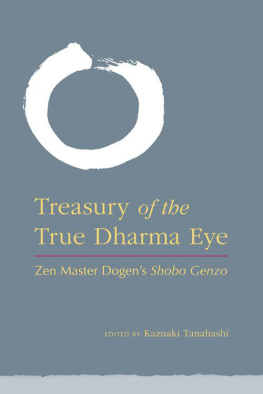This collection... is an occasion for celebration by American Buddhists.... those concerned with the living meaning embedded in these writings can only feel gratitude for the riches Cleary has provided.
Tricycle
Thomas Clearys strong rendering of important sections of Dogen Zenjis essential writings, with his excellent and comprehensive notes, opens the gate to a far wider understanding and appreciation of the extraordinary work of the founder of Japanese Zen.
Peter Matthiessen, author of Nine-Headed Dragon River
My reverence for both Dogen and Cleary is virtually unbounded.... It is becoming hard, in fact, to read anyones translations but Clearys.
Jim Harrison, author of Legends of the Fall
A vivid and fresh new translation.... Cleary preserves Dogens form and... succeeds in creating an atmosphere that awakens the essence of Dogen Zenjis teachings for American Zen students.
Hakuyu Taizan Maezumi, Roshi
ABOUT THE BOOK
Zen has often been portrayed as being illogical and mystifying, even aimed at the destruction of the rational intellect. These new translations of the thirteenth-century Zen master Dogenone of most original and important Zen writersillustrate the rational side of Zen, which has been obscured through the centuries, tainting peoples understanding of it.
Rational Zen consists of enlightening selections from Dogens two masterworks, Treasury of Eyes of True Teaching (the famed Shobogenzo, Japans most sophisticated philosophical work) and Universal Book of Eternal Peace, which until now has been unavailable in English. The translator also provides explanations of the inner meanings of Dogens writings and sayingsthe first commentaries of their kind of English. A compendium of authentic source materials further enhances the readers insight into Dogens methods, linking them to the great classical traditions of Buddhism that ultimately flowered in Zen.
THOMAS CLEARY holds a PhD in East Asian Languages and Civilizations from Harvard University and a JD from the University of California, Berkeley, Boalt Hall School of Law. He is the translator of over fifty volumes of Buddhist, Taoist, Confucian, and Islamic texts from Sanskrit, Chinese, Japanese, Pali, and Arabic.
Sign up to receive weekly Zen teachings from Shambhala Publications.

Or visit us online to sign up at shambhala.com/ezenquotes.
RATIONAL ZEN

The Mind of Dgen Zenji
TRANSLATED AND PRESENTED BY
THOMAS CLEARY

SHAMBHALA
Boston & London
2014
SHAMBHALA PUBLICATIONS, INC.
Horticultural Hall
300 Massachusetts Avenue
Boston, Massachusetts 02115
www.shambhala.com
1992 by Thomas Cleary
Cover art: Wen-shu, Patron of Learning, at a Writing Table (Yuan dynasty), Cincinnati Art Museum, Gift of C. T. Loo. Reproduced by permission.
All rights reserved. No part of this book may be reproduced in any form or by any means, electronic or mechanical, including photocopying, recording, or by any information storage and retrieval system, without permission in writing from the publisher.
The Library of Congress catalogues the hardcover edition of this book as follows:
Cleary, Thomas F., 1949
Rational Zen, the mind of Dgen Zenji/Thomas Cleary.1st ed.
p. cm.
Selected translation of the writings of Dgen Zenji from Japanese.
eISBN 978-0-8348-2945-9
ISBN 0-87773-689-8 (acid free paper)
ISBN 1-57062-634-0 (pbk.)
1. Dgen, 12001253. 2. StshDoctrines. I. Dgen, 12001253. Selections. 1992. II. Title.
BQ9449.D657C44 1992 92-50126
294.3927dc20 CIP
BVG 01

This book contains diacritics and special characters. If you encounter difficulty displaying these characters, please set your e-reader device to publisher defaults (if available) or to an alternate font.

Among the diverse roots of Japanese civilization, Buddhism is preeminent in providing an intellectual outlook that can transcend national cultures and sustain a genuine egalitarian global vision. This quality of Buddhism derives in part from its history as a spiritual culture absorbed by many different national and ethnic cultures and in part from the intrinsic nature of its philosophy. It is also the only universalistic thought ever widely accepted among the Japanese people.
The first and only major Buddhist work to be composed in the Japanese language is the colossal Shbgenz, or Treasury of Eyes of True Teaching, composed by the brilliant thirteenth-century Zen master Dgen Zenji. Neither the extraordinary literary quality nor the consummate metaphysical adroitness of this work has ever been surpassed in Japan; it stands on a par with the greatest of parallel literature throughout the world.
As a groundbreaking masterwork in what was for Buddhism a local and nonhieratic language, Dgens Shbgenz was not only a landmark in Japanese and East Asian intellectual history; it also ranks in sophistication with similar achievements taking place at more or less the same time in Europe, West Asia, and Central Asia in the use of Catalan, Persian, and Tibetan languages to express the sacred knowledge of gnostic Christianity, Sufism, and Tantric Buddhism.
The critical influence of Zen Buddhism on Japanese culture has long been recognized in the West through the writings of the late D. T. Suzuki. Because his voluminous writings have had in turn so much impact on Western ideas of Zen and Japanese culture, Suzukis effect on Western attitudes was tremendous. The peculiar fact that his works disregard Dgen Zenji, however, who was indisputably Japans most intelligent and most articulate Zen master, has resulted in correspondingly distorted views of Zen and the Japanese culture and mentality.
This is not the first time Dgen Zenji has been overlooked in Zen studies, in spite of the fact that his work is now recognized throughout the world for its extraordinary power of vision and expression. Dgens Shbgenz was not published for five hundred years after his death, and for most of that time was not studied even in the Zen schools tracing their descent to his direct disciples.
During the eighteenth and nineteenth centuries, only members of the St schools of Zen read Dgen; and most of them read very little of Dgens massive body of teachings. In the late nineteenth century, more than six hundred years after his passing, Dgen was granted a Daishi, or Great Master, title of honor by the Meiji emperor of Japan; and in the twentieth century his work became the subject of intense secular scrutiny, first in Japan, then throughout the world.
Nevertheless, while intellectuals worked to draw meanings from a difficult text with no historical transmission, Dgen was virtually ignored in D. T. Suzukis popular presentations of Zen and Japanese culture to mass Western audiences, which included a whole range of interests from philosophers and artists to religious and secular intellectuals involved in the soft sciences. Not until recently did there begin to develop widespread recognition of Dgens work, still perceived but dimly through linguistic and conceptual barriers.
Most of Dgens teaching is encapsulated in two works: the aforementioned
Next page
